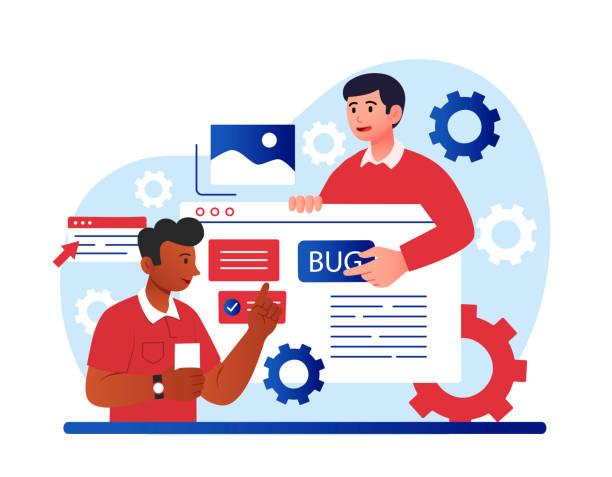The Importance of Secure Website Design in Today’s Digital World

In the current era, where the internet has become an inseparable part of daily life and businesses, the importance of #Secure_Website_Design is more evident than ever.
Every website, from a simple personal blog to a large e-commerce platform, is exposed to numerous cyber threats.
These threats can vary from phishing attacks and malware to Distributed Denial of Service (DDoS) attacks and SQL injection.
The main goal of #Website_Security is to protect sensitive user information, maintain data integrity, and ensure the availability of services.
This section, in an explanatory and educational manner, shows you why a proactive approach to secure website design is a vital investment, not an extra cost.
Failure to address security issues can lead to loss of customer trust, heavy financial losses, and even legal penalties.
Your website not only represents your brand but also bears the responsibility of protecting user data.
Therefore, every stage of the web development process, from platform selection to coding and deployment, must be carried out with cybersecurity in mind.
In this article, we comprehensively examine various aspects of secure website design so that you can create a strong security framework for your website.
How much does losing business leads due to an unprofessional website cost you? Solve this problem forever with professional corporate website design by Rasawab!
✅ Increased credibility and trust of potential customers
✅ Easier acquisition of new business leads
⚡ Get a free consultation now!
Understanding Common Cyber Threats and Web Vulnerabilities

To design a truly secure website, we must first become familiar with the types of cyber threats that target websites and common vulnerabilities.
This section provides an analytical and specialized review of these issues.
SQL Injection attacks, where an attacker injects malicious code into input fields to gain access to the database, are one of the oldest and most common threats.
XSS (Cross-Site Scripting) attacks are also dangerous, as they allow an attacker to execute malicious JavaScript code in the victim’s browser.
Distributed Denial of Service (DDoS) attacks render a website inaccessible by sending a massive volume of traffic to the server.
Software vulnerabilities resulting from outdated or unpatched code, incorrect server configurations, and the use of insecure plugins are also common weaknesses.
Additionally, phishing and social engineering attacks can trick users into revealing their login credentials.
Awareness of these threats and vulnerabilities is the first step in secure website design.
For a website with secure website design, a deep understanding of these mechanisms is essential to implement effective countermeasures.
Essential Standards and Protocols for Secure Website Design

Implementing security standards and encryption protocols is one of the first and most crucial steps in secure website design.
This section provides a guiding and specialized introduction to these topics.
SSL/TLS certificates (Secure Sockets Layer/Transport Layer Security) are essential for encrypting communications between the user’s browser and the website server.
These certificates ensure that transmitted data, such as credit card information or passwords, cannot be read by third parties during transit.
Without SSL, your website will be marked as “insecure” by browsers, which significantly impacts user trust.
In addition to SSL, adhering to the principles of secure coding is also vital.
This includes rigorous user input validation, using prepared statements to prevent SQL injection, and proper error handling.
Furthermore, using a powerful firewall (WAF – Web Application Firewall) can help protect the website against common application layer attacks.
Here is a table of essential security protocols that should be considered:
| Protocol/Standard | Description | Importance for Secure Website Design |
|---|---|---|
| SSL/TLS | Encrypts communication between browser and server | Essential for protecting sensitive data and gaining trust |
| HTTPS | Secure version of HTTP using SSL/TLS | Current standard for secure web communications |
| HSTS (HTTP Strict Transport Security) | Forces browsers to use HTTPS for the site | Prevents Man-in-the-Middle attacks by enforcing HTTPS |
| CSP (Content Security Policy) | Controls resources that the browser can load | Reduces the risk of XSS and data injection attacks |
Implementing these protocols and standards provides a robust foundation for any secure website design and significantly reduces vulnerability risks.
Secure Coding Principles and the Developer’s Role in Building a Secure Website

A significant portion of secure website design relies on developers’ coding approaches.
This section addresses secure coding principles in a specialized and educational manner.
Developers must integrate security into the Software Development Life Cycle (SDLC) from the outset.
This means that security should not be considered as a post-development phase but should be given attention at every stage, from design and planning to testing and deployment.
One of the most important principles is rigorous user input validation.
Any data coming from the user must be carefully examined to prevent any malicious code or unauthorized input.
Using Prepared Statements in database interactions is crucial to prevent SQL Injection.
Additionally, strong encryption (such as salted hashing) should be used for storing passwords, and they should never be kept in plain text.
Error and log management must also be done carefully; excessive error information can provide clues to attackers.
Programmers should use up-to-date and reputable frameworks and libraries that have themselves been security tested.
Continuous training for developers on the latest threats and best practices in secure coding is also highly important.
Secure website design requires the commitment of all development team members to security principles.
Implementing these principles in every line of code significantly enhances your website’s resilience against attacks and protects it from many common vulnerabilities.
Did you know that 94% of the first impressions of a company are related to its website design?
Rasawab, by providing professional corporate website design services, helps you create the best first impression.
✅ Creating a professional and trustworthy image for your brand
✅ Easier attraction of potential customers and improvement of online standing
⚡ Get a free corporate website design consultation
Database Security: Protecting Sensitive User Information

The database is the heart of every website, storing sensitive user information, including names, addresses, contact information, and even payment details.
Therefore, database security is considered a critical component of secure website design.
This section addresses this topic in a specialized and guiding manner.
The first step is to use strong encryption for sensitive data both at rest and in transit.
For example, credit card information should never be stored without encryption.
Database access management is also very important.
Every user or service accessing the database must have the principle of least privilege.
This means that a user should only have access to the information necessary to perform their duties and no more.
Using strong and unique passwords for database accounts, and changing them periodically, is also a fundamental principle.
Databases must be regularly backed up, and these backups should be stored in a secure location separate from the main server to allow for quick recovery in case of ransomware attacks or data loss.
Furthermore, applying security patches and software updates for the Database Management System (DBMS) as soon as they are released is crucial.
Monitoring database activities to identify suspicious patterns and intrusion attempts is also an effective preventive measure.
A secure website design would be incomplete without a secure database.
User Authentication and Access Management: Creating Layers of Defense

In any secure website design, how users are authenticated and how their access to various website resources is managed is of paramount importance.
This section provides an educational and specialized explanation of these defense layers.
Strong authentication is the first barrier against unauthorized access.
Using complex passwords that include a combination of uppercase and lowercase letters, numbers, and symbols is essential.
Additionally, enforcing mandatory password change policies can enhance security.
Two-Factor Authentication (2FA) or Multi-Factor Authentication (MFA) is a highly important security layer.
This method requires user identity verification through two or more independent factors (such as a password and a code sent to a mobile device) and prevents attacker intrusion even if the password is compromised.
Access management (Authorization) begins after authentication and determines which resources an authenticated user can access and what operations they can perform.
The principle of Least Privilege should be followed; meaning that each user or user role should only have the minimum access necessary to perform their duties.
Role-Based Access Control (RBAC) systems help organize access based on predefined roles.
For instance, a regular user will not have access to the website’s administrative section, while a super administrator can access all sections.
Logging and monitoring unsuccessful login attempts and suspicious user activities are also crucial for identifying intrusion attempts.
Secure website design involves designing a system that not only makes unauthorized entry difficult but also ensures that authorized users only have access to what they need.
Regular Updates and Security Patches: Key to Website Security Stability
![]()
No secure website design can remain stable without a commitment to regular updates and applying security patches.
This section addresses the importance of this topic in a news-like and guiding manner.
Cyber threats are constantly evolving, and attackers continuously seek new vulnerabilities in common software, including Content Management Systems (CMS) like WordPress or Joomla, frameworks, plugins, and even server operating systems.
Software developers release security patches as soon as vulnerabilities are discovered.
Failure to apply these patches promptly puts your website at serious risk.
Regular updates include the CMS core, all plugins and extensions, themes, and also server software such as Apache, Nginx, PHP, and MySQL.
For a secure website design, a regular schedule for checking and applying updates must be maintained.
This can be done manually or using automated tools, but it is always recommended to create a full backup of the website before applying major updates.
Below is a checklist of items that should be regularly updated:
| Item | Suggested Frequency | Importance Description |
|---|---|---|
| CMS Core (WordPress, Joomla, etc.) | As soon as security patches are released | Fixes critical vulnerabilities in the main platform |
| Plugins and Extensions | As soon as updates are released | Many attacks occur through vulnerable plugins |
| Themes | As soon as updates are released | Outdated themes can be entry points |
| Server OS (Linux, Windows) | Regular monthly/quarterly scheduling | Protects the website’s underlying infrastructure |
| Programming Environment (PHP, Node.js, Python, etc.) | According to new stable versions | Benefits from security and performance improvements |
This continuous commitment to maintenance and updates ensures your website’s security against new threats and is an integral part of a successful secure website design.
Planning for Security Incidents and Backup Strategies

Even with the best secure website design approaches, the possibility of security incidents is not entirely eliminated.
Therefore, having a documented Incident Response Plan and Backup Strategies is critically important.
This section addresses this topic in an explanatory and guiding manner.
The incident response plan should include clear steps for identification, containment, eradication, recovery, and post-incident analysis.
Upon identifying an attack, rapid action to contain it is crucial to prevent further damage.
The responsible team must know exactly who is responsible for what and how to manage internal and external communications.
Regular and automated backups of all website data, including files, images, databases, and configurations, are a final line of defense.
These backups should be stored in different locations (such as cloud storage, separate servers, or even physical disks) to minimize the risk of data loss.
The key point is that backups must be recoverable; therefore, periodically testing the recovery process is as important as the backup itself.
The 3-2-1 strategy for backups is recommended: three copies of data, on two different types of storage media, and one copy off-site.
This approach minimizes the risk of data loss and ensures that your website is recoverable in any scenario.
A secure website design is only complete when it includes a disaster recovery plan.
Did you know that 94% of users’ first impressions of a business are related to its website design? With professional corporate website design by **Rasawab**, turn this first impression into an opportunity for growth.
✅ Attract more customers and increase sales
✅ Build credibility and trust in the audience’s eyes⚡ Get a free website design consultation!
Security Monitoring and Penetration Testing: Tools for Continuous Evaluation

To ensure that your secure website design remains effective, continuous security monitoring and regular penetration testing are essential.
This section discusses these tools in a specialized and analytical manner.
Security monitoring involves overseeing server logs, website traffic, and suspicious user activities.
SIEM (Security Information and Event Management) tools can help collect, analyze, and correlate these logs, allowing you to quickly identify threats.
Automated alerts for unusual activities, such as repeated failed login attempts, unauthorized file uploads, or unusual traffic patterns, should be configured.
Penetration Testing is a controlled simulation of a real cyberattack performed by security specialists.
The purpose of these tests is to identify vulnerabilities that may have been overlooked during the secure website design process.
This includes testing for SQL injection, XSS, checking for misconfigurations, weaknesses in session management and authentication, and other potential vulnerabilities.
After penetration testing, a comprehensive report of discovered vulnerabilities and recommendations for their remediation is provided.
Vulnerability scanners can also automatically scan the website for known vulnerabilities.
A combination of real-time monitoring, periodic penetration testing, and automated scans provides a comprehensive approach to maintaining your website’s security and ensures that your secure website design remains resilient against new and evolving threats.
The Future of Secure Website Design and Challenges Ahead

The world of cybersecurity is constantly changing and evolving, and secure website design is no exception.
This section explores future challenges and trends in this field in an engaging and thought-provoking manner.
With the emergence of new technologies such as Artificial Intelligence (AI) and Machine Learning (ML), both attackers and defenders have new tools at their disposal.
Can AI make cyberattacks so sophisticated that defending against them becomes almost impossible? Or can AI help us identify and counter threats in ways we never imagined?
One of the main challenges is the rise of identity-based attacks that utilize more sophisticated phishing and advanced social engineering.
How can we educate users to be resilient against these attacks? Can passwordless authentication solutions shape the future of security?
The Internet of Things (IoT) and the increasing number of connected devices also create a wider attack surface.
How can the security of websites interacting with these devices be ensured? Also, with the growth of Cloud Computing, security responsibility is divided between the cloud service provider and the user.
Understanding this shared responsibility model is crucial for any secure website design in a cloud environment.
The future of secure website design requires flexibility, continuous innovation, and collaboration among security specialists, developers, and users to remain resilient against future challenges and provide a safer online environment.
Frequently Asked Questions
| No. | Question | Answer |
|---|---|---|
| 1 | What does secure website design mean? | Secure website design refers to a set of measures and methods used to protect a website against cyberattacks, unauthorized access, data breaches, and other security threats. Its goal is to maintain the confidentiality, integrity, and availability of information. |
| 2 | Why is website security important? | Website security is vital for maintaining user trust, protecting sensitive information (such as personal and financial data), preventing financial losses, preserving brand reputation, and complying with legal regulations (like GDPR). A security breach can lead to customer loss and heavy penalties. |
| 3 | What are some of the most common security attacks against websites? | Common attacks include SQL Injection, XSS (Cross-Site Scripting), CSRF (Cross-Site Request Forgery), Brute Force, DDoS attacks, Broken Authentication, and Missing Function Level Access Control. |
| 4 | What is the role of an SSL/TLS certificate in website security? | An SSL/TLS certificate (which leads to an HTTPS address) is used to encrypt data exchanged between the user and the website server. This prevents eavesdropping or tampering with sensitive information such as passwords and credit card details during transmission and verifies the website’s authenticity. |
| 5 | How can SQL Injection attacks be prevented? | To prevent SQL Injection, Prepared Statements or ORM (Object-Relational Mapping) with validated parameters should be used. Additionally, thorough user input filtering and validation (Input Validation) and applying the principle of least privilege in the database are essential. |
| 6 | What is the HTTP Strict Transport Security (HSTS) protocol and how does it help with security? | HSTS is a web security policy that instructs browsers to load the website only via an HTTPS connection, even if the user enters the address with HTTP. This prevents Downgrade attacks and cookie hijacking on public Wi-Fi networks. |
| 7 | What is the importance of regular software and plugin updates in website security? | Regularly updating the Content Management System (CMS), plugins, themes, and other software components of the site is crucial for patching discovered security vulnerabilities. Developers continuously release security patches, and failing to update can leave the site vulnerable to known attacks. |
| 8 | What measures can be taken to increase the security of the website administration section (admin panel)? | Changing the default admin panel path, using strong passwords and two-factor authentication (2FA), restricting access to specific IPs, using CAPTCHA on login pages, monitoring logs, and continuous CMS updates are among these measures. |
| 9 | Why is user input filtering and validation (Input Validation) important? | Input filtering and validation help prevent the injection of malicious code or unauthorized data through forms, URLs, or other user input sections. This prevents attacks like XSS and SQL Injection, which exploit invalid inputs. |
| 10 | Name a few common tools or services for checking and enhancing website security. | Tools such as Web Application Firewalls (WAF), vulnerability scanners (e.g., Acunetix, Nessus), Intrusion Detection and Prevention Systems (IDS/IPS), CDN services with security features (e.g., Cloudflare), and periodic Penetration Testing can enhance website security. |
And other services by Rasa Web advertising agency in the field of advertising
Smart Website Development: An effective tool for analyzing customer behavior with Google Ads management.
Smart Customer Journey Map: A dedicated service for growth in customer acquisition based on SEO-driven content strategy.
Smart Data Analysis: Designed for businesses looking to manage campaigns through Google Ads management.
Smart Brand Identity: Transform campaign management with the help of user experience customization.
Smart Sales Automation: A dedicated service for digital branding growth based on precise audience targeting.
And over a hundred other services in the field of internet advertising, advertising consulting, and organizational solutions.
Internet Advertising | Advertising Strategy | Advertorials
Sources
Cybersecurity Guide
Cybersecurity on Wikipedia
Cybersecurity Developments
Cybersecurity Basics
? For your business to leap forward in the digital world and experience unparalleled growth, Rasawab Afarin is your smart companion. With our expertise in SEO, content marketing, and especially user-friendly website design, you will have a powerful and lasting presence on the web.
📍 Tehran, Mirdamad Street, next to the Central Bank, Southern Kazeroun Alley, Ramin Alley, No. 6



